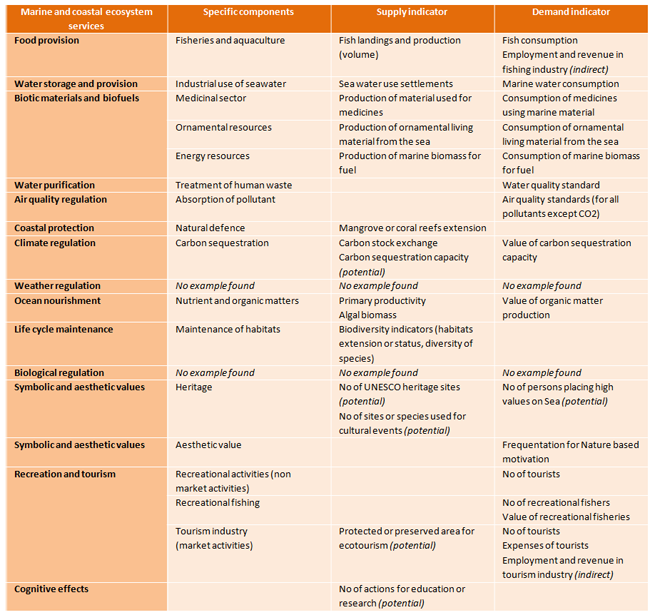3.1.6 Indicators for the assessment of marine ecosystem services

Any assessment framework should include a minimum set of indicators to represent the multiple facets of ecosystem services and the related complexity of biophysical processes and social issues [Carpenter et al., 2006].
Ecosystem service indicators are statistics or other forms of information including maps, which communicate the characteristics of ecosystem services in a form that is easily understood and applied by diverse audiences; ecosystem service indicators relay information about the overall magnitude and trends in ecosystem services [UNEP, 2009].
Because of the difficultly in measuring the flow of benefits from some regulating and cultural services, it may be necessary to rely on proxy indicators for some ecosystem services, in particular for some regulating and cultural services. In principle, indicators of ecosystem services ideally convey information about the flow of service, which corresponds to the benefits people receive [UNEP, 2009].
However, it may be necessary to consider stock or status indicators for the purpose of an integrated assessment framework which would consider not only ecosystem services, but also ecological functions.
At the present time, there is no scientific consensus on a minimal set of indicators for assessing marine ecosystem services. In the context of the VALMER project, it was suggested that indicators should be selected, within the lists provided hereafter, by the study site team together with the end-users (managers, stakeholders), who may prefer particular indicators or metrics, depending on the scope of the assessment and their judgement criteria.
Whatever the aim of the ecosystem services assessment, it remains necessary to distinguish supply and demand indicators. Supply indicators characterize the ability of the ecosystem to deliver a particular flow service: in that case the service may be actual (the default) or potential. Demand indicators characterize the requirement or concern of human population, subject to economic and social circumstances: in that case, the service may be direct (the default) or indirect. According to the above definitions, monetary values of ecosystem services are always demand indicators, subject to a particular social and economic context.
Table: Supply and Demand indicators for Marine ecosystem services assessment.(Source: Mongruel et al., 2015; UNEP, 2009 and Liquete et al., 2013)


